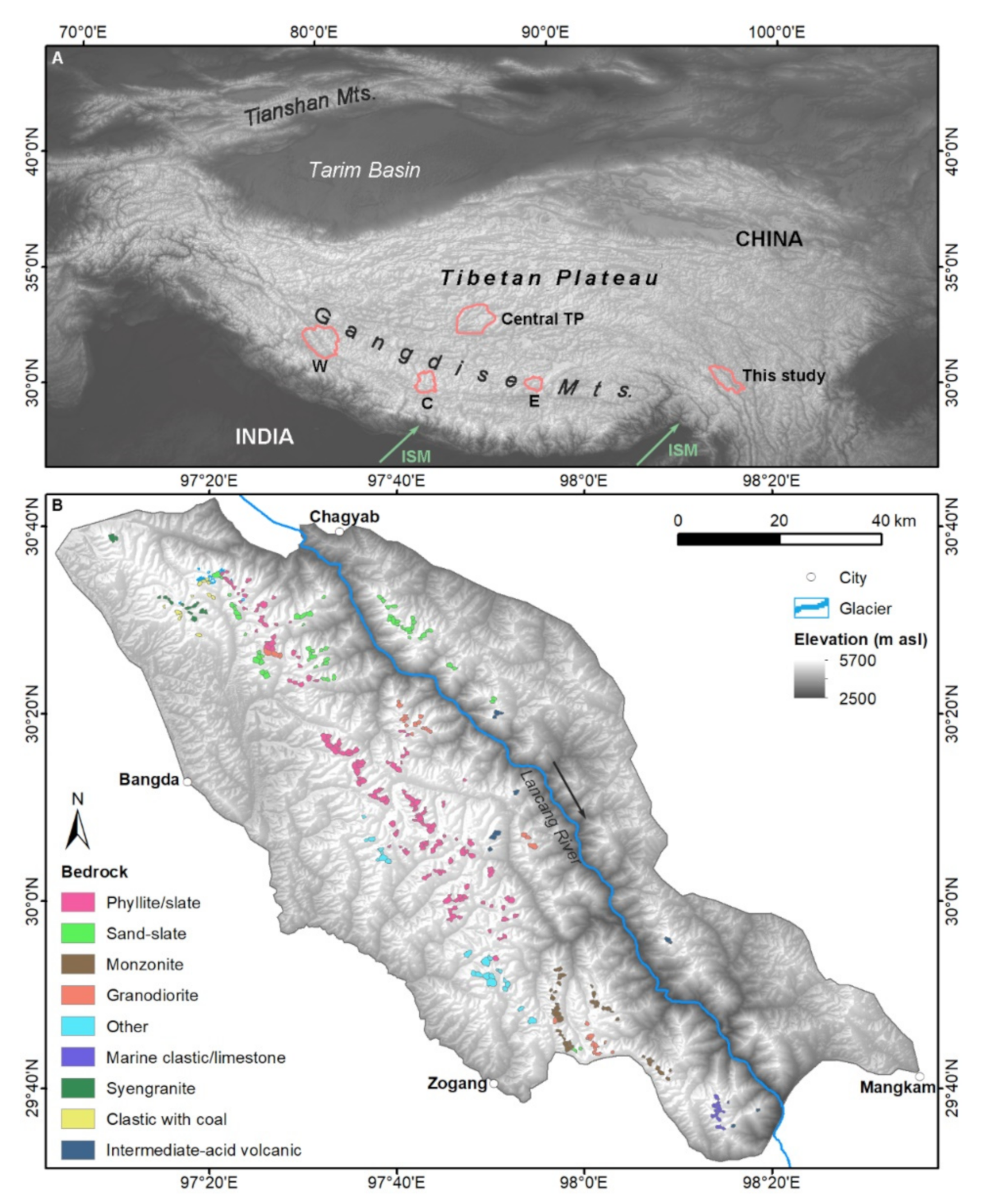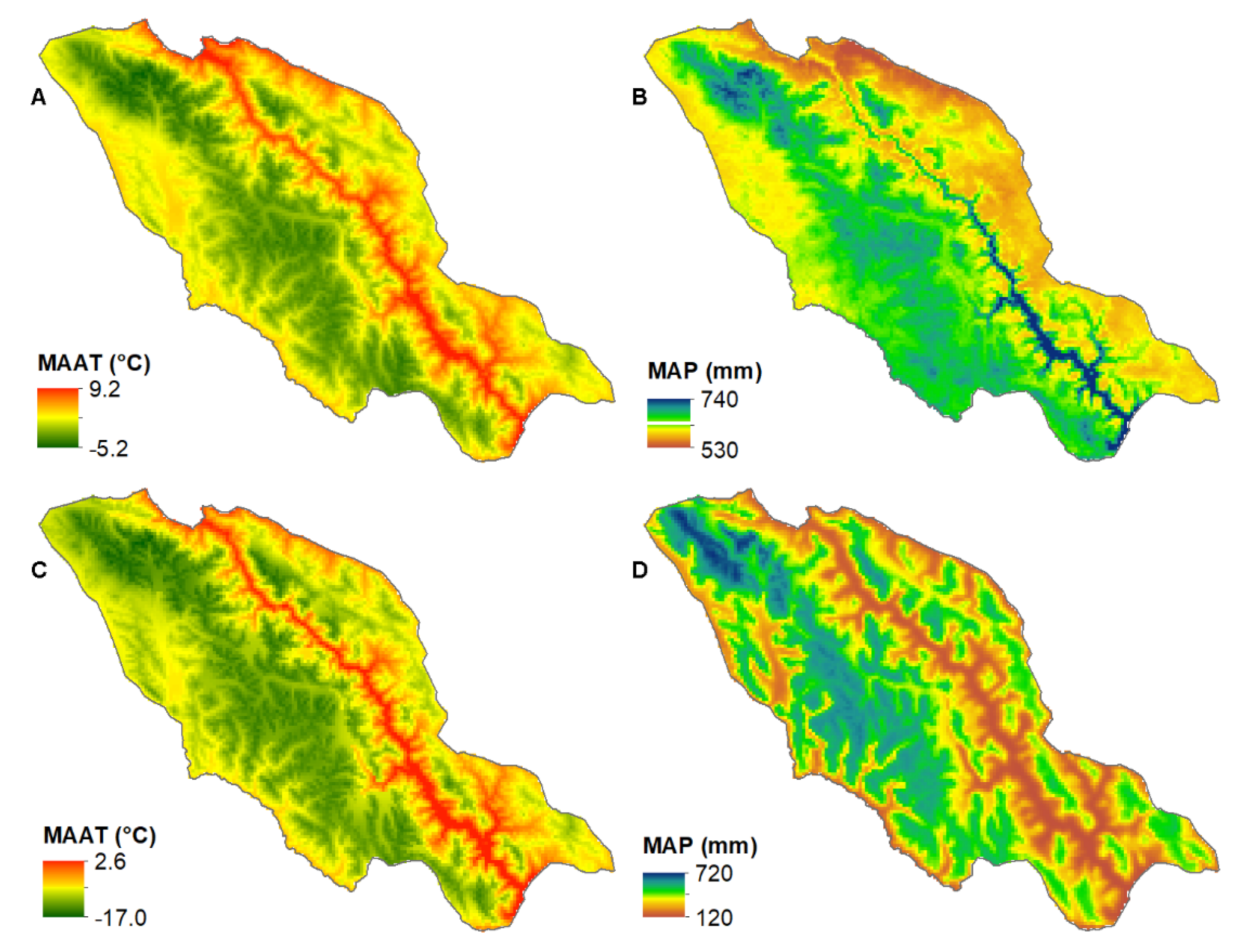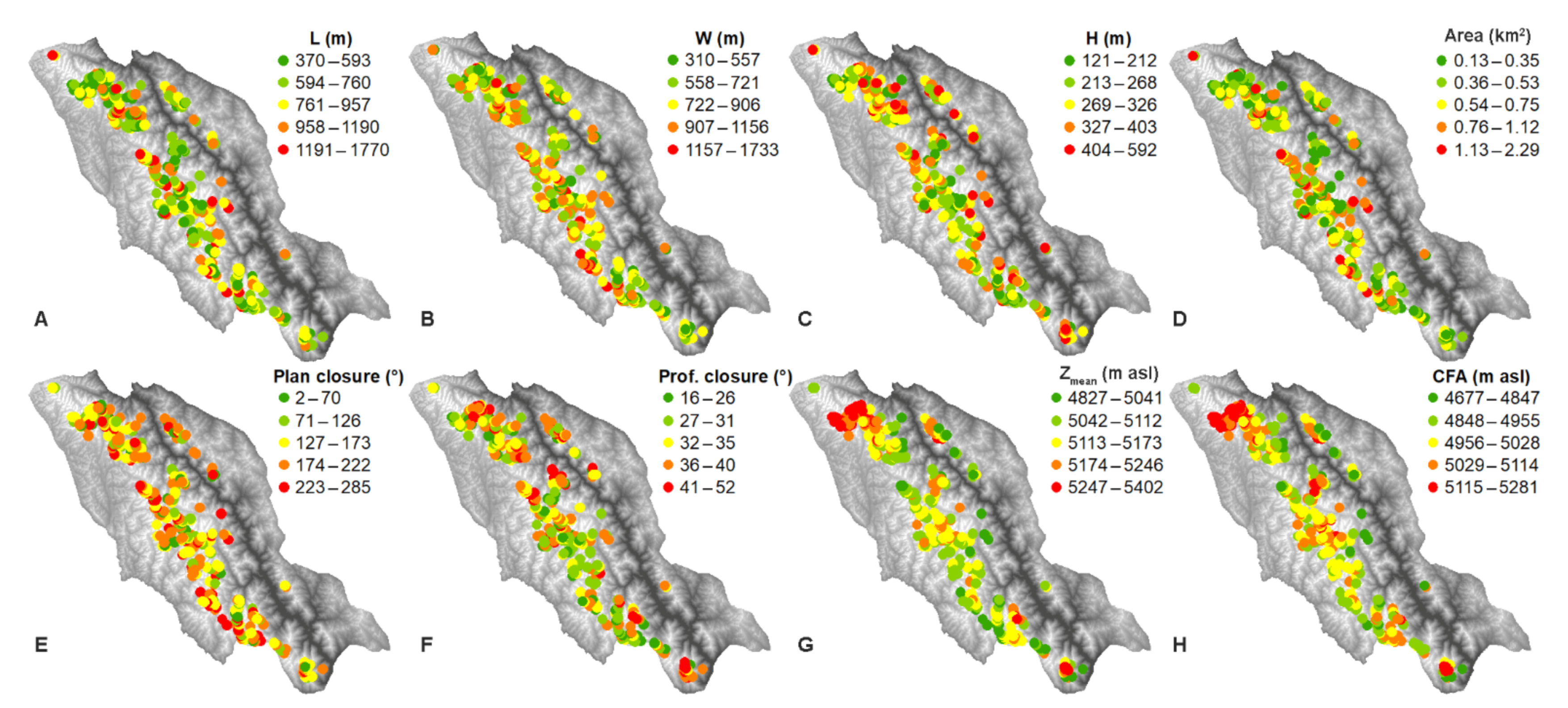Cirques of the Southeastern Tibetan Plateau and Their Links to Climatic and Non-Climatic Factors
Abstract
1. Introduction
2. Study Area
3. Methods
4. Results
4.1. Cirque Size, Shape, and Development Degree
4.2. Cirque Altitude, Slope, and Aspect
4.3. Cirque Lithology
5. Discussion
5.1. Impact of Climatic and Non-Climatic Factors on Cirques
5.2. Monsoon’s Role on Cirques
6. Conclusions
Supplementary Materials
Author Contributions
Funding
Acknowledgments
Conflicts of Interest
References
- Barr, I.D.; Ely, J.C.; Spagnolo, M.; Evans, I.S.; Tomkins, M.D. The dynamics of mountain erosion: Cirque growth slows as landscapes age. Earth Surf. Processes Landf. 2019, 44, 2628–2637. [Google Scholar] [CrossRef]
- Barr, I.D.; Spagnolo, M. Glacial cirques as palaeoenvironmental indicators: Their potential and limitations. Earth-Sci. Rev. 2015, 151, 48–78. [Google Scholar] [CrossRef]
- Oliva, L.; Cioccale, M.A.; Rabassa, J.O. Morphometry and spatial distribution of glacial cirques in the Western Fuegian Andes of Argentina, southernmost South America. Andean Geol. 2020, 47, 316–350. [Google Scholar] [CrossRef]
- Pedraza, J.; Carrasco, R.M.; Villa, J.; Soteres, R.L.; Karampaglidis, T.; Fernández-Lozano, J. Cirques in the Sierra de Guadarrama and Somosierra Mountains (Iberian Central System): Shape, size and controlling factors. Geomorphology 2019, 341, 153–168. [Google Scholar] [CrossRef]
- Wallick, K.N.; Principato, S.M. Quantitative analyses of cirques on the Faroe Islands: Evidence for time transgressive glacier occupation. Boreas 2020, 49, 828–840. [Google Scholar] [CrossRef]
- Zhang, Q.; Dong, W.; Dou, J.; Dong, G.; Zech, R. Cirques of the central Tibetan Plateau: Morphology and controlling factors. Palaeogeogr. Palaeoclimatol. Palaeoecol. 2021, 582, 110656. [Google Scholar] [CrossRef]
- Zhang, Q.; Fu, P.; Yi, C.; Wang, N.; Wang, Y.; Capolongo, D.; Zech, R. Palaeoglacial and palaeoenvironmental conditions of the Gangdise Mountains, southern Tibetan Plateau, as revealed by an ice-free cirque morphology analysis. Geomorphology 2020, 370, 107391. [Google Scholar] [CrossRef]
- Thompson, L.G.; Yao, T.; Davis, M.E.; Mosley-Thompson, E.; Wu, G.; Porter, S.E.; Xu, B.; Lin, P.-N.; Wang, N.; Beaudon, E.; et al. Ice core records of climate variability on the Third Pole with emphasis on the Guliya ice cap, western Kunlun Mountains. Quat. Sci. Rev. 2018, 188, 1–14. [Google Scholar] [CrossRef]
- Walder, J.S.; Hallet, B. The physical basis of frost weathering: Toward a more fundamental and unified perspective. Arct. Alp. Res. 1986, 18, 27–32. [Google Scholar] [CrossRef]
- Battey, M.H. Geological factors in the development of Veslgjuv-Botn and Vesl-Skautbotn. In Norwegian Cirque Glaciers; Lewis, W.V., Ed.; Royal Geographical Society Research Series; Royal Geographical Society: London, UK, 1960; Volume 4, pp. 5–10. [Google Scholar]
- White, W.A. Erosion of cirques. J. Geol. 1970, 78, 123–126. [Google Scholar] [CrossRef]
- Pelto, M.S. Equilibrium line altitude variations with latitude, today and during the Late Wisconsin. Palaeogeogr. Palaeoclimatol. Palaeoecol. 1992, 95, 41–46. [Google Scholar] [CrossRef]
- Porter, S.C. Composite pleistocene snow line of Olympic Mountains and Cascade Range, Washington. Geol. Soc. Am. Bull. 1964, 75, 477–482. [Google Scholar] [CrossRef]
- Porter, S.C. Some geological implications of average Quaternary glacial conditions. Quat. Res. 1989, 32, 245–261. [Google Scholar] [CrossRef]
- Williams, L.D. The variation of corrie elevation and equilibrium line altitude with aspect in eastern Baffin Island, NWT, Canada. Arct. Alp. Res. 1975, 7, 169–181. [Google Scholar] [CrossRef]
- Dou, J.; Mou, J.; Zhang, Q. Cirque floor altitude of the Gangdise Mountains and its controlling factors. Front. Earth Sci. 2022, 10, 900141. [Google Scholar] [CrossRef]
- Fick, S.E.; Hijmans, R.J. WorldClim 2: New 1-km spatial resolution climate surfaces for global land areas. Int. J. Climatol. 2017, 37, 4302–4315. [Google Scholar] [CrossRef]
- RGI Consortium. Randolph Glacier Inventory—A Dataset of Global Glacier Outlines, Version 6.0: Technical Report, Global Land Ice Measurements from Space; RGI Consortium: Boulder, CO, USA, 2017. [Google Scholar]
- Zhang, W.; Chai, L. The preliminary study of the Quaternary glacier in middle part of the Tenasserim Chain with ESR dating method. J. Glaciol. Geocryol. 2016, 38, 1281–1291, (in Chinese with English abstract). [Google Scholar]
- Zhang, W.; Chai, L.; Evans, I.S.; Liu, L.; Li, Y.-P.; Qiao, J.-R.; Tang, Q.-Y.; Sun, B. Geomorphic features of Quaternary glaciation in the Taniantaweng Mountain, on the southeastern Qinghai-Tibet Plateau. J. Mt. Sci. 2019, 16, 256–274. [Google Scholar] [CrossRef]
- Karger, D.N.; Conrad, O.; Böhner, J.; Kawohl, T.; Kreft, H.; Soria-Auza, R.W.; Zimmermann, N.E.; Linder, H.P.; Kessler, M. Climatologies at high resolution for the earth’s land surface areas. Sci. Data 2017, 4, 170122. [Google Scholar] [CrossRef] [PubMed]
- Gordon, J.E. Morphometry of cirques in the Kintail-Affric-Cannich area of northwest Scotland. Geogr. Ann. Ser. A Phys. Geogr. 1977, 59, 177–194. [Google Scholar] [CrossRef]
- Evans, I.; Cox, N. The form of glacial cirques in the English-Lake-District, Cumbria. Z. Geomorphol. 1995, 39, 175–202. [Google Scholar] [CrossRef]
- Mîndrescu, M.; Evans, I.S. Cirque form and development in Romania: Allometry and the buzzsaw hypothesis. Geomorphology 2014, 208, 117–136. [Google Scholar] [CrossRef]
- Evans, I.S. Allometric development of glacial cirque form: Geological, relief and regional effects on the cirques of Wales. Geomorphology 2006, 80, 245–266. [Google Scholar] [CrossRef]
- Barr, I.D.; Ely, J.C.; Spagnolo, M.; Clark, C.D.; Evans, I.S.; Pellicer, X.M.; Pellitero, R.; Rea, B.R. Climate patterns during former periods of mountain glaciation in Britain and Ireland: Inferences from the cirque record. Palaeogeogr. Palaeoclimatol. Palaeoecol. 2017, 485, 466–475. [Google Scholar] [CrossRef]
- Curray, J.R. The Analysis of Two-Dimensional Orientation Data. J. Geol. 1956, 64, 117–131. [Google Scholar] [CrossRef]
- Evans, I.S. World-wide variations in the direction and concentration of cirque and glacier aspects. Geogr. Ann. Ser. A Phys. Geogr. 1977, 59, 151–175. [Google Scholar] [CrossRef]
- Farinotti, D.; Huss, M.; Fürst, J.J.; Landmann, J.; Machguth, H.; Maussion, F.; Pandit, A. A consensus estimate for the ice thickness distribution of all glaciers on Earth. Nat. Geosci. 2019, 12, 168–173. [Google Scholar] [CrossRef]
- Spagnolo, M.; Pellitero, R.; Barr, I.D.; Ely, J.C.; Pellicer, X.M.; Rea, B.R. ACME, a GIS tool for Automated Cirque Metric Extraction. Geomorphology 2017, 278, 280–286. [Google Scholar] [CrossRef]
- Chengdu Institute of Geology and Mineral Resources. China Geological Survey. Geological Map of the Tibetan Plateau and Its Adjacent Areas; Chengdu Cartographic Publishing House: Chengdu, China, 2004. [Google Scholar]
- Welch, B.L. On the comparison of several mean values: An alternative approach. Biometrika 1951, 38, 330–336. [Google Scholar] [CrossRef]
- Reed, J.F.; Stark, D.B. Robust alternatives to traditional analysis of variance: Welch W∗, James JI∗, James JII∗, Brown-Forsythe BF∗. Comput. Methods Programs Biomed. 1988, 26, 233–237. [Google Scholar] [CrossRef]
- Murari, M.K.; Owen, L.A.; Dortch, J.M.; Caffee, M.W.; Dietsch, C.; Fuchs, M.; Haneberg, W.C.; Sharma, M.C.; Townsend-Small, A. Timing and climatic drivers for glaciation across monsoon-influenced regions of the Himalayan–Tibetan orogen. Quat. Sci. Rev. 2014, 88, 159–182. [Google Scholar] [CrossRef]
- Brown, J.L.; Hill, D.J.; Dolan, A.M.; Carnaval, A.C.; Haywood, A.M. PaleoClim, high spatial resolution paleoclimate surfaces for global land areas. Sci. Data 2018, 5, 180254. [Google Scholar] [CrossRef] [PubMed]
- Evans, I.S. Climatic effects on glacier distribution across the Southern Coast Mountains. B.C., Canada. Ann. Glaciol. 1990, 14, 58–64. [Google Scholar] [CrossRef]
- Evans, I.S. Local aspect asymmetry of mountain glaciation: A global survey of consistency of favoured directions for glacier numbers and altitudes. Geomorphology 2006, 73, 166–184. [Google Scholar] [CrossRef]



| Minimum | Maximum | Mean | Std. Deviation | Skewness | |
|---|---|---|---|---|---|
| L (m) | 370 | 1770 | 787 | 248.21 | 0.96 |
| W (m) | 310 | 1733 | 795 | 234.84 | 0.68 |
| H (m) | 121 | 592 | 293 | 77.43 | 0.58 |
| Area (km2) | 0.13 | 2.29 | 0.56 | 0.31 | 1.47 |
| L/W | 0.46 | 2.15 | 1.02 | 0.28 | 0.60 |
| L/H | 1.25 | 4.72 | 2.73 | 0.64 | 0.63 |
| W/H | 0.95 | 5.32 | 2.80 | 0.77 | 0.66 |
| Plan closure (°) | 2 | 285 | 162 | 61.33 | −0.51 |
| Profile closure (°) | 16 | 52 | 33 | 6.12 | 0.29 |
| Zmean (m asl) | 4827 | 5402 | 5144 | 86.01 | 0.25 |
| CFA (m asl) | 4677 | 5281 | 5010 | 102.65 | −0.10 |
| Smean (°) | 14.55 | 35.46 | 23.61 | 3.44 | 0.52 |
| Log of | L | W | H | Area | L/W | L/H | W/H | Plan Closure | Profile Closure | Zmean | CFA | Smean | MAAT | MAP |
|---|---|---|---|---|---|---|---|---|---|---|---|---|---|---|
| L | 1.00 | 0.58 | 0.67 | 0.88 | 0.47 | 0.53 | −0.03 | 0.28 | 0.37 | −0.35 | 0.07 | −0.15 | 0.26 | −0.23 |
| W | 1.00 | 0.53 | 0.87 | −0.45 | 0.15 | 0.57 | 0.27 | 0.30 | −0.33 | −0.01 | −0.12 | 0.17 | −0.16 | |
| H | 1.00 | 0.67 | 0.17 | −0.27 | −0.40 | 0.09 | 0.53 | −0.28 | 0.04 | 0.45 | 0.29 | −0.22 | ||
| Area | 1.00 | 0.03 | 0.38 | 0.28 | 0.31 | 0.38 | −0.38 | 0.04 | −0.17 | 0.23 | −0.21 | |||
| L/W | 1.00 | 0.42 | −0.65 | 0.02 | 0.08 | −0.03 | 0.08 | −0.03 | 0.10 | −0.08 | ||||
| L/H | 1.00 | 0.42 | 0.26 | −0.13 | −0.14 | 0.04 | −0.71 | 0.02 | −0.05 | |||||
| W/H | 1.00 | 0.20 | −0.19 | −0.09 | −0.05 | −0.56 | −0.09 | 0.04 | ||||||
| Plan closure | 1.00 | 0.08 | −0.23 | 0.04 | −0.11 | 0.14 | −0.14 | |||||||
| Profile closure | 1.00 | 0.07 | −0.01 | 0.37 | 0.06 | 0.02 | ||||||||
| Zmean | 1.00 | −0.10 | 0.10 | −0.78 | 0.70 | |||||||||
| CFA | 1.00 | 0.07 | 0.13 | −0.04 | ||||||||||
| Smean | 1.00 | 0.04 | 0.01 | |||||||||||
| MAAT | 1.00 | −0.73 | ||||||||||||
| MAP | 1.00 |
| Altitude (m asl) | Nr | L (m) | W (m) | H (m) | Area (km2) | L/W | L/H | W/H | Plan Closure (°) | Profile Closure (°) | Zmean (m asl) | CFA (m asl) | Smean (°) | VM (°) | VS (%) |
|---|---|---|---|---|---|---|---|---|---|---|---|---|---|---|---|
| ≤5000 | 14 | 952 | 868 | 377 | 0.72 | 1.10 | 2.56 | 2.41 | 193.00 | 32.68 | 4960 | 5086 | 25.69 | 357.90 | 72.95 |
| 5001–5100 | 97 | 887 | 867 | 318 | 0.69 | 1.05 | 2.82 | 2.82 | 174.97 | 33.10 | 5066 | 5012 | 23.34 | 15.47 | 43.33 |
| 5101–5200 | 166 | 770 | 812 | 281 | 0.55 | 0.98 | 2.77 | 2.95 | 160.68 | 32.50 | 5144 | 5008 | 23.12 | 43.08 | 45.28 |
| 5201–5300 | 69 | 689 | 683 | 275 | 0.42 | 1.06 | 2.59 | 2.56 | 148.52 | 34.46 | 5246 | 4997 | 24.54 | 60.01 | 30.80 |
| ≥5301 | 15 | 626 | 600 | 263 | 0.32 | 1.10 | 2.51 | 2.43 | 114.53 | 34.73 | 5343 | 5004 | 24.70 | 126.75 | 66.77 |
| p-value b | 0.000 | 0.000 | 0.000 | 0.000 | 0.107 | 0.054 | 0.000 | 0.001 | 0.236 | 0.000 | 0.133 | 0.003 |
| Aspect | Nr | L (m) | W (m) | H (m) | Area (km2) | L/W | L/H | W/H | Plan Closure (°) | Profile Closure (°) | Zmean (m asl) | CFA (m asl) | Smean (°) |
|---|---|---|---|---|---|---|---|---|---|---|---|---|---|
| N | 63 | 736 | 762 | 278 | 0.50 | 1.00 | 2.70 | 2.81 | 175.54 | 32.72 | 5121 | 5018 | 23.85 |
| NE | 82 | 785 | 811 | 297 | 0.56 | 1.02 | 2.68 | 2.80 | 155.40 | 34.10 | 5128 | 5007 | 23.36 |
| E | 82 | 859 | 808 | 299 | 0.63 | 1.07 | 2.90 | 2.79 | 154.87 | 34.29 | 5159 | 4987 | 22.88 |
| SE | 26 | 802 | 788 | 291 | 0.57 | 1.05 | 2.85 | 2.80 | 133.12 | 34.73 | 5214 | 5025 | 22.64 |
| S | 18 | 747 | 756 | 267 | 0.50 | 1.03 | 2.80 | 2.87 | 170.50 | 31.84 | 5186 | 5020 | 23.32 |
| SW | 15 | 806 | 860 | 311 | 0.61 | 1.03 | 2.67 | 2.92 | 164.67 | 31.89 | 5178 | 5005 | 23.29 |
| W | 30 | 790 | 818 | 309 | 0.58 | 0.98 | 2.61 | 2.73 | 174.07 | 29.73 | 5134 | 5027 | 25.43 |
| NW | 45 | 730 | 774 | 290 | 0.52 | 0.98 | 2.57 | 2.75 | 168.67 | 32.14 | 5114 | 5025 | 24.66 |
| p-value b | 0.111 | 0.826 | 0.282 | 0.381 | 0.517 | 0.127 | 0.998 | 0.073 | 0.007 | 0.000 | 0.420 | 0.010 |
| Bedrock Types | Nr | L (m) | W (m) | H (m) | Area (km2) | L/W | L/H | W/H | Plan Closure (°) | Profile Closure (°) | Zmean (m asl) | CFA (m asl) | Smean (°) |
|---|---|---|---|---|---|---|---|---|---|---|---|---|---|
| Phyllite/slate | 152 | 785 | 811 | 280 | 0.57 | 1.00 | 2.84 | 2.95 | 159.01 | 32.58 | 5146 | 5003 | 22.99 |
| Sand–slate | 63 | 786 | 780 | 325 | 0.54 | 1.04 | 2.45 | 2.46 | 168.17 | 34.30 | 5140 | 5029 | 25.28 |
| Monzonite | 38 | 778 | 754 | 289 | 0.52 | 1.06 | 2.73 | 2.72 | 162.55 | 31.90 | 5106 | 4963 | 22.53 |
| Granodiorite | 33 | 761 | 765 | 294 | 0.52 | 1.04 | 2.69 | 2.71 | 154.55 | 33.82 | 5118 | 4965 | 24.33 |
| Other | 23 | 944 | 1002 | 296 | 0.86 | 0.93 | 3.12 | 3.40 | 193.17 | 31.67 | 5100 | 5073 | 22.07 |
| Marine clastic/limestone | 14 | 747 | 659 | 332 | 0.43 | 1.19 | 2.29 | 2.07 | 147.21 | 41.36 | 5234 | 5067 | 27.11 |
| Syengranite | 14 | 750 | 744 | 261 | 0.51 | 1.02 | 2.85 | 2.97 | 157.07 | 30.18 | 5235 | 4984 | 22.74 |
| Clastic with coal | 12 | 617 | 722 | 237 | 0.39 | 0.91 | 2.68 | 3.04 | 134.92 | 32.80 | 5289 | 5021 | 23.06 |
| Intermediate-acid volcanic | 12 | 881 | 790 | 337 | 0.60 | 1.13 | 2.68 | 2.40 | 162.50 | 33.16 | 5052 | 5110 | 24.69 |
| p-value b | 0.018 | 0.004 | 0.001 | 0.004 | 0.085 | 0.000 | 0.000 | 0.274 | 0.000 | 0.000 | 0.000 | 0.000 |
| Central TP | W Gangdise Mountains | C Gangdise Mountains | E Gangdise Mountains | Southeastern TP | |
|---|---|---|---|---|---|
| MAAT (°C) | −10 to 1 | ~−14 to 4 | ~−11 to 3 | ~−8 to 5 | −5.2 to 9.2 |
| MAP (mm) | 110 to 230 | ~80 to 460 | ~130 to 310 | ~230 to 420 | 530 to 740 |
| Density (n km–2) | 0.006 | 0.036 | 0.072 | 0.187 | 0.043 |
| L (m) | 984 | 1033 | 960 | 815 | 787 |
| W (m) | 860 | 1014 | 838 | 741 | 795 |
| H (m) | 370 | 367 | 365 | 330 | 293 |
| Area (km2) | 0.78 | 0.94 | 0.74 | 0.55 | 0.56 |
| L/W | 1.21 | 1.06 | 1.18 | 1.13 | 1.02 |
| L/H | 2.78 | 2.85 | 2.65 | 2.49 | 2.73 |
| W/H | 2.43 | 2.86 | 2.39 | 2.32 | 2.80 |
| Plan closure (°) | 157 | / | / | / | 162 |
| Profile closure (°) | 59 | / | / | / | 33 |
| Zmean (m asl) | / | 5676 | 5776 | 5526 | 5144 |
| CFA (m asl) | 5352 | 5508 | 5613 | 5371 | 5010 |
| Smean (°) | / | 22 | 24 | 25 | 23.61 |
| Sources | [6] | [7] | This study | ||
Publisher’s Note: MDPI stays neutral with regard to jurisdictional claims in published maps and institutional affiliations. |
© 2022 by the authors. Licensee MDPI, Basel, Switzerland. This article is an open access article distributed under the terms and conditions of the Creative Commons Attribution (CC BY) license (https://creativecommons.org/licenses/by/4.0/).
Share and Cite
Li, S.; Zhang, Q.; Wang, J. Cirques of the Southeastern Tibetan Plateau and Their Links to Climatic and Non-Climatic Factors. Int. J. Environ. Res. Public Health 2022, 19, 13104. https://doi.org/10.3390/ijerph192013104
Li S, Zhang Q, Wang J. Cirques of the Southeastern Tibetan Plateau and Their Links to Climatic and Non-Climatic Factors. International Journal of Environmental Research and Public Health. 2022; 19(20):13104. https://doi.org/10.3390/ijerph192013104
Chicago/Turabian StyleLi, Shengxian, Qian Zhang, and Jiahan Wang. 2022. "Cirques of the Southeastern Tibetan Plateau and Their Links to Climatic and Non-Climatic Factors" International Journal of Environmental Research and Public Health 19, no. 20: 13104. https://doi.org/10.3390/ijerph192013104
APA StyleLi, S., Zhang, Q., & Wang, J. (2022). Cirques of the Southeastern Tibetan Plateau and Their Links to Climatic and Non-Climatic Factors. International Journal of Environmental Research and Public Health, 19(20), 13104. https://doi.org/10.3390/ijerph192013104





